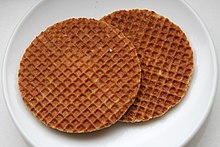Waffle

A waffle is a batter cake cooked in a waffle iron patterned to give a distinctive and characteristic shape. There are several regional variations based on the type and shape of the iron and the batter recipe.
Varieties of waffle
- The Brussels waffle[1] or Belgian waffle is prepared from a yeast-leavened batter. It is often, but not always, lighter, thicker, crispier, and/or has larger pockets compared to other waffle varieties. It is often served warm by street vendors, dusted with confectioner's sugar, and sometimes topped with whipped cream or chocolate spread. It may also be served as a dessert, with fruits or ice cream.

- The Liège waffle[2] (from the city of Liège, in eastern Belgium) is a waffle usually bought and eaten warm on the street. They are usually freshly made in small shops, but it is also possible to buy them in supermarkets. They are smaller, sweeter, and denser than "Belgian waffles". The last-minute addition of nib sugar to the batter produces a caramelized sugar coating. This gives a distinctive flavor. Most are served plain, but some are vanilla or cinnamon flavored, and can be served with toppings like fruits, creams, and chocolate. The Liège waffle was invented by a cook of the prince-bishop of Liège in the 18th century.
- American waffles[3], common in the United States, are made from a batter leavened with baking powder, rather than yeast. They are usually served as a sweet breakfast food, topped with butter and various syrups, but are also found in many different savory dishes, such as chicken and waffles or topped with kidney stew.[4] They are generally denser and thinner than the Belgian waffle. Waffles were first introduced to North America in 1620 by Pilgrims who brought the method from Holland. Thomas Jefferson brought a waffle iron from France, and waffle frolics or parties became popular in the late eighteenth century.[citation needed]
- Hong Kong style waffle, in Hong Kong called a "grid cake" (格仔餅), is a waffle usually made and sold by street hawkers and eaten warm on the street.[5] They are similar to a traditional waffle but larger, round in shape and divided into four quarters. They are usually served as a snack. Butter, peanut butter and sugar are spread on one side of the cooked waffle and then it is folded into a semi circle to eat. Egg, sugar and evaporated milk are used in the waffle recipes, giving them a sweet flavor. They are generally soft and not dense. Traditional Hong Kong style waffles are full of the flavor of yolk. Sometimes different flavors, such as chocolate and honey melon flavor are used in the recipe and create various colors.

- Stroopwafels (Dutch: syrup waffles) are thin waffles with a syrup filling. They were first made in Gouda in the Netherlands, during the 18th or 19th century. The stiff batter for the waffles is made from flour, butter, brown sugar, yeast, milk, and eggs. Medium sized balls of batter are put on the waffle iron. When the waffle is baked, and while it is still warm, it is cut into two halves. The warm filling, made from syrup, brown sugar, butter, and cinnamon, is spread in between the waffle halves, which glues them together.[6] They are popular in Belgium and the Netherlands.

Medieval origins
The modern waffle has its origins in the wafers – very light thin crisp cakes, baked between wafer-irons – of the Middle Ages. [7] Wafer irons consisted of two metal plates connected by a hinge, with each plate connected to an arm with a wooden handle. The iron was placed over a fire, and flipped to cook both sides of the wafer. These irons were used to produce a variety of different flat, unleavened cakes (usually from a mixture of barley and oats, not the white flour used today).
In 14th century England, wafers were sold by street vendors called waferers.[8] The modern waffle is a leavened form of wafer.
"Wafer" and "waffle" share common etymological roots. Wafre (wafer) occurs in Middle English by 1377, adopted from Middle Low German wâfel, with change of l into r. Modern Dutch wafel, French gaufre, and German Waffel, all meaning "waffle", share the same origin. The Dutch form, wafel, was adopted into modern American English as waffle, in the 18th century.[7][9]
See also
References
- ^ Brussels Waffle recipe
- ^ Liège waffle recipe
- ^ American waffle recipe
- ^ Davidson, Alan (1999). The Oxford Companion to Food. Oxford: Oxford University press. pp. xx + 892. ISBN 0-19-211579.
{{cite book}}: Check|isbn=value: length (help); Cite has empty unknown parameter:|coauthors=(help) - ^ Descriptions of Hong Kong Waffles
- ^ Stroopwafels. Traditional delicacys. Retrieved on 2008-01-02
- ^ a b Oxford English Dictionary
External links
- Picture of wafers being made from around 1340
- Food timeline entry for waffles
- Discussion of wafers in the Middle Ages
- [1] Turkey Traditional Waffle Offical Website
- Waffle recipes in the Cookbook wikibook
